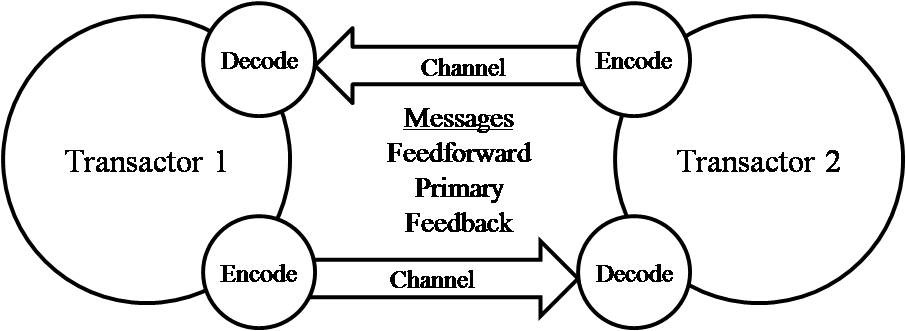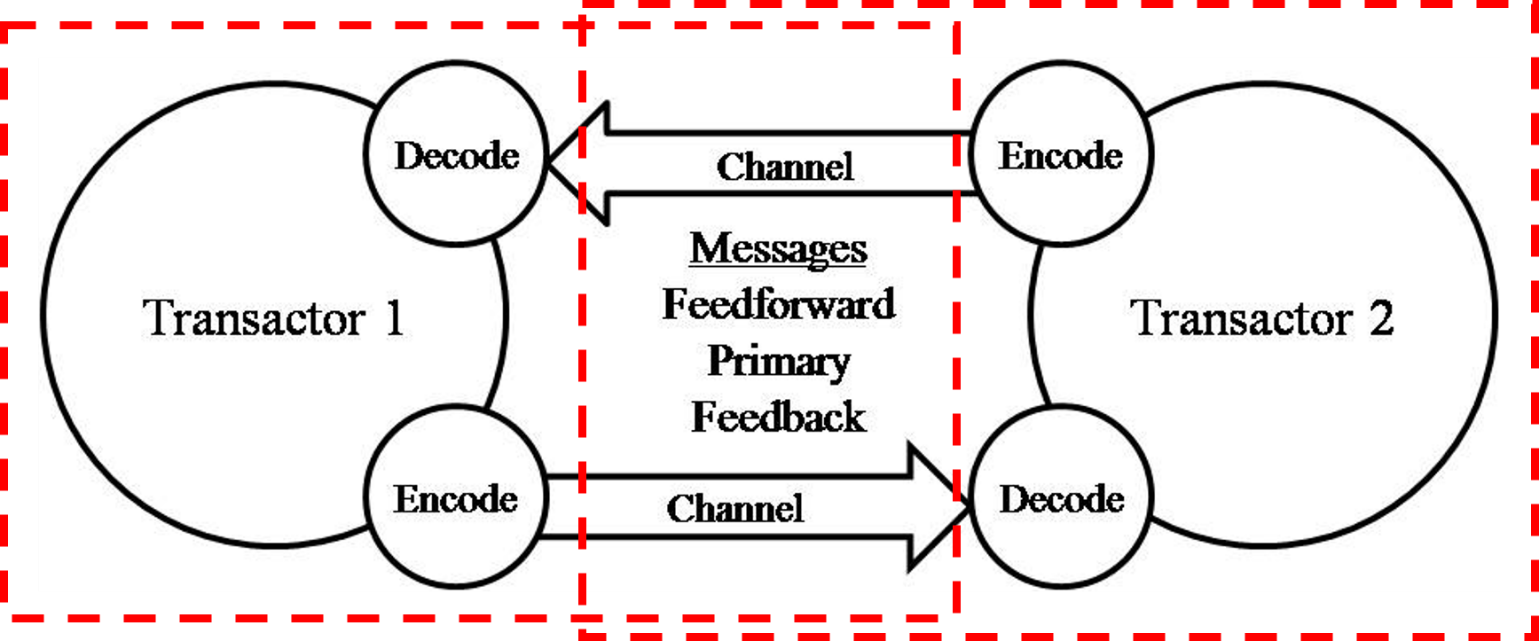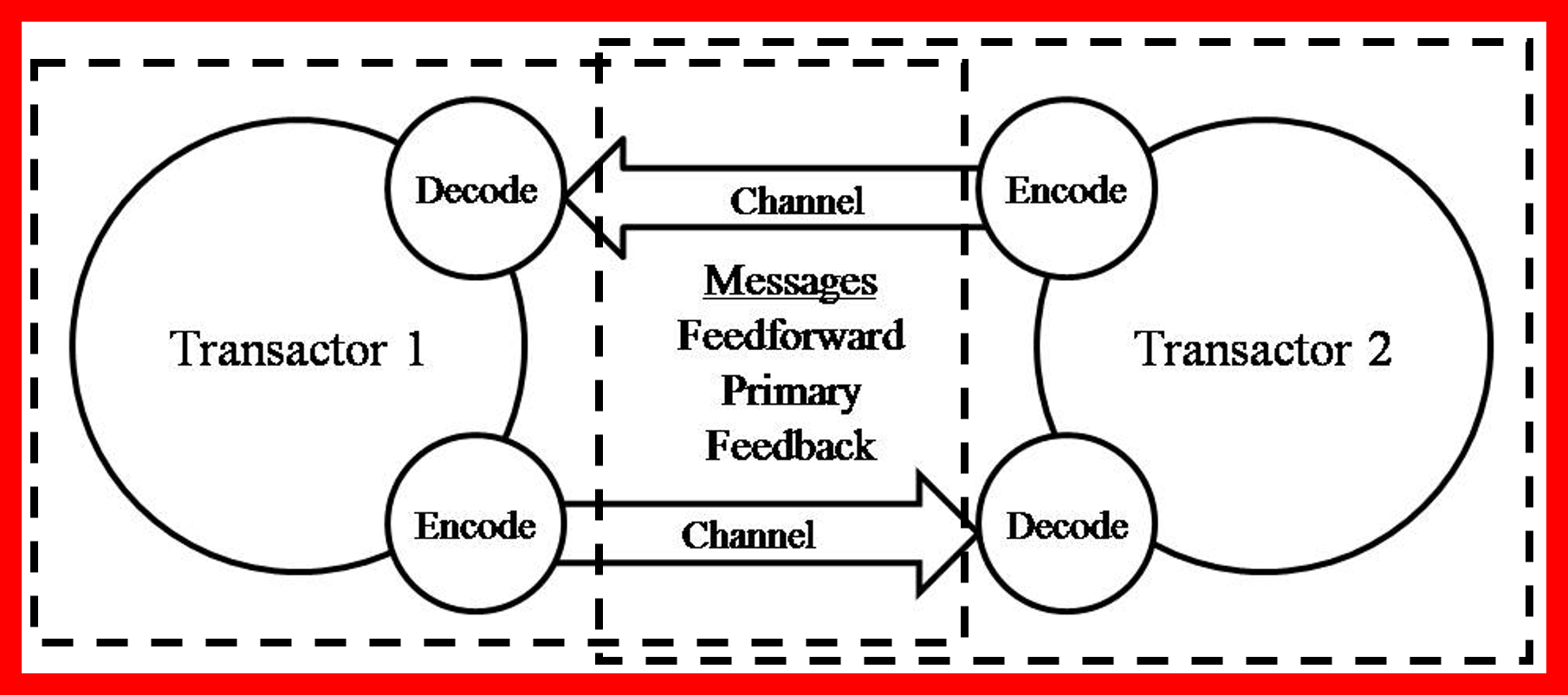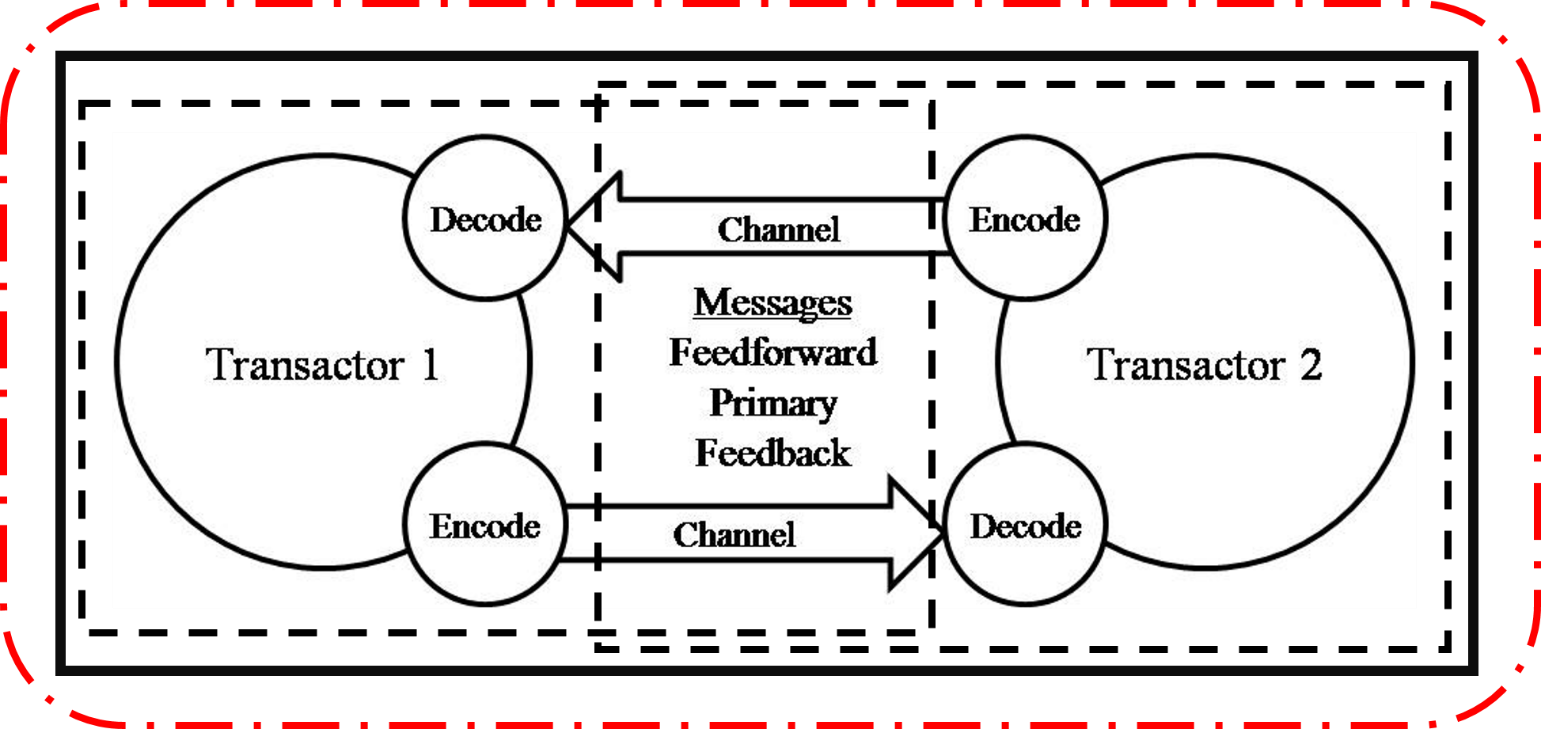Module I: Communication TheorySection 2: The Communication ModelAfter completing this section, students should be able to:
The communication process is comprised of many interdependent components, all working in concert to attempt to achieve quality interaction. If any one of these components is weak, the overall process is hurt, and it is virtually always hurt in some manner. To better see how communication flows and how the parts work together, we use a visual model. The transactional model helps describe how communication occurs, and it also prescribes how communication should occur. The core of the model is the transactional process of sending messages between the transactors.
Each “person” is a transactor, a person who is sending and receiving messages simultaneously. To communicate a message, the transactor has to encode, that is they have to select the verbal and nonverbal symbols to send to the other person. Once encoded, they have to use the channel, the physical means of transmission, to actually deliver the symbols. For example, when speaking face-to-face, the channels would be sound waves (created by the voice) and light waves (looking at the person). When texting, the channel would be the electronic delivery system of a cellphone. Once the symbols are received, the person must decode; they must attach meaning to those symbols. It is very important to remember how the receiver decodes will never be exactly the same as what was intended by the sender; there is always a difference of interpretation, even if slight. Each transactor is both encoding and decoding. As the transactional theory of communication says, we send and receive multiple messages simultaneously, thus the model needs to represent these concurrent processes. As we send these symbols back and forth, we hope the receiver understands what we intended. The message is the meaning intended by the source. As mentioned earlier, regardless of what is intended, the receiver will always interpret the symbols somewhat differently, and sometimes very differently than intended. We send three types of messages. The first of these, feedforward, is a message sent before the primary message to establish a context for interpretation (Devito, 1996). In effect, this gives the receiver some warning to prepare for what is coming. If Professor White says, “Have you heard the joke about the professor and the duck?”, the student knows she wants the message interpreted in a humorous manner. When a significant other says, “We need to talk,” such feedforward is often taken as a precursor to a fairly serious conversation. Even something as simple as an instructor saying, “Today we’re going to review the communication model” is a type of feedforward, preparing the student for what is to come. The primary message is the core message we intend to communicate. After we provide the feedforward, “Have you heard the joke about the professor and the duck,” the joke is the primary message. Feedback is the reaction to the primary message. This feedback can range from subtle to overt. Subtle feedback consists of very slight facial expression changes or other such barely noticeable clues. Many of us have had the experience of saying something to a person, then getting a nagging feeling we irritated them. It is possible we are picking up on some very subtle feedback, without realizing it. Overt feedback is highly noticeable, such as comments, questions, or laughter. The next layer of the model, Image 14, consists of a dotted line box drawn around each transactor. This represents field of experience. The transactor’s field of experience is everything about them or the total accumulation of all their knowledge, experience, values, interests, beliefs, and personality. It is the “box” they live in. Note from the model, how we encode and decode is based on our field of experience; we are taught how to communicate.
Of special significance in the model is the degree of overlap of the fields of experience. As a rule, the greater the degree of overlap, the higher the quality of communication. For example, a long-term couple, married for 30 years, will probably understand each other’s communication better and more precisely than a couple on their third date. The married couple has a much higher overlap in their fields of experience; they have shared a lot of language, and have had multiple opportunities to figure out what the other means by certain expressions and manners of communication. The young couple is still figuring each other out; the overlap in their field of experience is far smaller. A common error we make is assuming we have no shared field of experience with those from different cultures. While those in foreign countries and cultures seem so unlike us, the fact is we do share much, the common experience of being human. International/intercultural experiences can demonstrate the things we see as differences, such as language, dress, and food, are actually fairly superficial. Once we get past those differences, we see we are all going about our day-to-day lives. While the media often plays up conflicts between countries and cultures, our individual, human similarities far outweigh those differences.
The thick, heavy red line encompassing the model in image 3 represents noise. Noise is anything interfering with clear communication, and no matter how we try, noise is always present to some degree. Noise can affect the transactors, the channel, the encoding or decoding, or any aspect of the process. Three types of noise are present: internal, external, and semantic. Internal noise refers to anything going on inside the body of the transactor which causes a distraction. Internal physical noise is anything physical inside the body interfering with the transactor’s ability to interact effectively. A headache, stomachache, or just being tired are all forms of internal physical noise. Students in long classes may experience the distraction of needing to use the restroom, counting the minutes until the teacher takes a break, obviously not focusing very well on the content of the course. Internal psychological noise refers to moods, attitudes, biases, or daydreaming. We all experience moody days, and know that during those times, a simple “good morning” may be enough to send us off on a tirade. We perceive the world differently as our moods flow. If we have biases against types of people, such as women, Latinos, athletes, or the elderly, we filter their messages differently than those for whom we do not have biases. Students in class with the “this is stupid” attitude will learn nothing. Little gets through that psychological filter, no matter how the teacher attempts to reach and engage them. Daydreams of sandy beaches and warm sun may be far more tempting than a lecture on economics, diverting the student from the message at hand. External noise is physical in nature. While internal noise exists within the bodies of the transactors, external noise exists in the outside environment. Loud sounds are common distractions; loud music, voices, sirens, or other extraneous sounds distract us from the message at hand. Smell can be a powerful form of external noise. As Americans, we tend to be fixated on odor, and for us to smell “human” is considered rude, so when we do encounter someone with noticeable body odor, we generally find it quite distracting. On the other hand, those who use excessive amounts of colognes or perfumes may also cause distractions. If the room is too hot, too cold, too bright, or too dim, we may have trouble really focusing on the primary message. Even visual distractions function as external noise. Trying to speak to someone at a large gathering with people moving about can be difficult; since we are attracted to movement, we can easily become distracted as people pass by. Semantic noise is a bit different. Semantics refers to language, so semantic noise refers to language problems. We can experience denotative semantic noise. Denotation is the dictionary definition of a word; it is the commonly accepted definition of a specific term. We experience this noise when we hear or see symbols we do not understand and to which we cannot attach meaning. The most extreme example of this is a foreign language. If Victoria is hearing Somali but does not speak Somali, she will not be able to interpret the message; she cannot attach a denotation to the symbol. More common, however, is our exposure to jargon or to high level language. Going to college is a good example of this. Ideally, we are exposed to a higher, more formal use of language we may find confusing at first. We are experiencing denotative semantic noise. Ideally this triggers us to learn these new words, incorporating them into our own vocabulary. When buying a new computer, the salesperson may use a lot of computer jargon, and if the customer is not familiar with that jargon, they experience denotative semantic noise. Going to college provides examples of this also. Examples of college "jargon" might include terms dealing with financial aid (FAFSA, Pell, etc.) or student programs (TRIO, Phi Theta Kappa, etc.). Higher-level language may come from a biology instructor’s lecture on the phylum Ciliophora or from a communication textbook’s section on semantics. While we should be exposed to a higher, more formal use of language in college, many may find the change confusing at first. If so, we are experiencing denotative semantic noise. Connotative semantic noise is more of an emotional issue with language. With denotative semantic noise, we cannot cognitively understand the word; it is a rational, intellectual problem. The connotation of the word is the implied judgment of the word; or what the word suggests about how the speaker feels about the person or object being referenced. For example, in a college classroom, if an instructor refers to students as “men and women,” that suggest a significantly different perception than if she were to use “boys and girls.” Most racist and sexist terms are really issues of connotation, not denotation. Racial slurs are intended as judgmental statements about that person, race, or ethnic group. Professional labels demonstrate the significance of connotation: “administrative assistant” implies a far more important position than “secretary,” even if the duties are the same. Garbage collectors may be referred to as “sanitation engineers,” or janitors become “physical plant engineers.”
The last component of the communication model is context. Context is the environment of the communication, but it is far more than the actual location. Each contextual variable influences the process in its own way. First, there is the social/physical context. A blending of two dynamics, the social/physical context refers to the actual location of the communication and the social rules associated with that physical location. All communication contexts have social rules associated with them. In a classroom, students are expected to be quiet, listen, take notes, and generally defer to the instructor. The teacher is supposed to focus on content, give an organized lecture, lead the class, and generally run things in the classroom. As the context changes, the rules change. The teacher can speak with a student in class, following the social/physical context rules of that location, but when he runs into the student at the grocery store, the rules for both are far more casual. The social/physical rules (the expectations for behavior) for an end-of-the-semester party at a friend’s apartment are far different than the social/physical rules for dining at a family restaurant. Third is the historical context. The historical context refers to the history of the relationship. We learn how to communicate with people over time. As we get to know each other, we learn what kind of communication works with different people. For example, teenagers learn how to be more persuasive with their parents over time. As intimate relationships develop, we learn what our partner is offended by, or the best way to express disagreement without triggering a fight. In school, most students have experienced how their ability to understand what the instructor expects improves as they get to know that instructor. We use those past communication encounters to know how to communicate in the present. One important aspect of historical context is the development of common language and common meaning. As our relationship develops we learn what each means by specific words or actions. Inside jokes are examples. Single words or short phrases may trigger laughter in those who know the context, while those not sharing the history are left wondering what they are missing. The reference only makes sense to those sharing a particular history. The last type of context is cultural. Culture is “a learned set of shared interpretations about beliefs, values, norms, and social practices which affect the behaviors of a relatively large group of people” (Lustig, 2010). These are deep-seated beliefs about the world that we learn as we grow, though often we are unaware of their presence. For example, today young women in the United States are free to pursue whatever professional or personal goals they wish; however, just a few decades ago it was assumed a young woman would be married, a mother, and a homemaker. If she was to work outside the home, it would have probably been as a nurse, teacher, or in other perceived “female” professions. She probably would have been paid about 2/3 of what a male would have been simply because the belief was, “men support families,” not women. Today, our culture is much different, and such discrimination based on sex is far rarer. In the past, especially in the Deep South, it was socially acceptable to refer to African-Americans using powerfully derogatory terms, but today we realize such terms are offensive and have no place in a culture espousing equality for all. As the culture changes, the expectations of behavior, including how we talk to each other, likewise change.
The terms and concepts students should be familiar with from this section include:
Lustig, M. W., & Koester, J. (2010). Intercultural competence: Interpersonal communication
across cultures (5th ed.). Boston, MA: Pearson/Allyn and Bacon.
| |||||||||||
| |||||||||||




